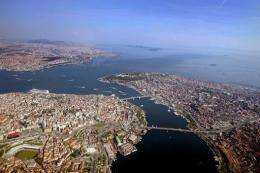New study sheds light on quake peril for Istanbul

An investigation into a perilous fault that runs south of Istanbul suggests it could unleash two or three big quakes in a series rather than an extremely large one-off event, as some studies have feared.
Until now, seismologists have estimated an earthquake as powerful as 7.5 or 7.6 magnitude could erupt in a fault under the Sea of Marmara, lying to the south of the great Turkish metropolis.
The fault is one of three fingers of the notorious North Anatolian Fault, which runs along Turkey's northern rim and is popping open from east to west, rather like shirt buttons that are ripped off one after another.
The 7.6-magnitude calculation is based on estimated slippage, an indicator of the amount of energy placed on the fault and the fault's response to it.
But a new study by a pair of German geophysicists says the slippage figure may have been over-estimated, given the challenge of getting an accurate picture of stress in this sub-sea segment.
Their 3D model of the fault's seismic mechanics points to annual slippage of between 12.8 and 17.8 millimetres (0.5-0.7 inches) per year, or as much as 45 percent less than estimated before. In addition, the movement rates vary by 40 percent along the main fault.
As a result, builtup energy could be released along the segment in a progressive string of ruptures at stress points, as opposed to a massive quake that would tear the section open in one go.
One of the authors, University of Karlsruhe geophysicist Tobias Hergert, said these quakes could be around 7.0 magnitude, which on the logarithmic scale is many times smaller than a 7.5 event.
"In terms of energy, the difference between seven and 7.5 is big. Even so, even a 7.0 earthquake might cause serious damage in the region. It would depend on where exactly the earthquake would nucleate and propagate," he told AFP.
The paper was published on Sunday in the journal Nature Geoscience.
The fault zone is less than 20 kilometres (12 miles) from Istanbul's boundary, which means the seismic hazard is "tremendously high," the paper adds.
Hergert said he had carried out other research which suggested the series of relatively smaller quakes could occur "in principle at any time", although this could also mean as long as 30 years from now.
Istanbul is home to 14 million people and hosts some of the world's architectural gems, dating back to the Roman and Byzantine empires and the golden age of Islamic building.
(c) 2010 AFP


















